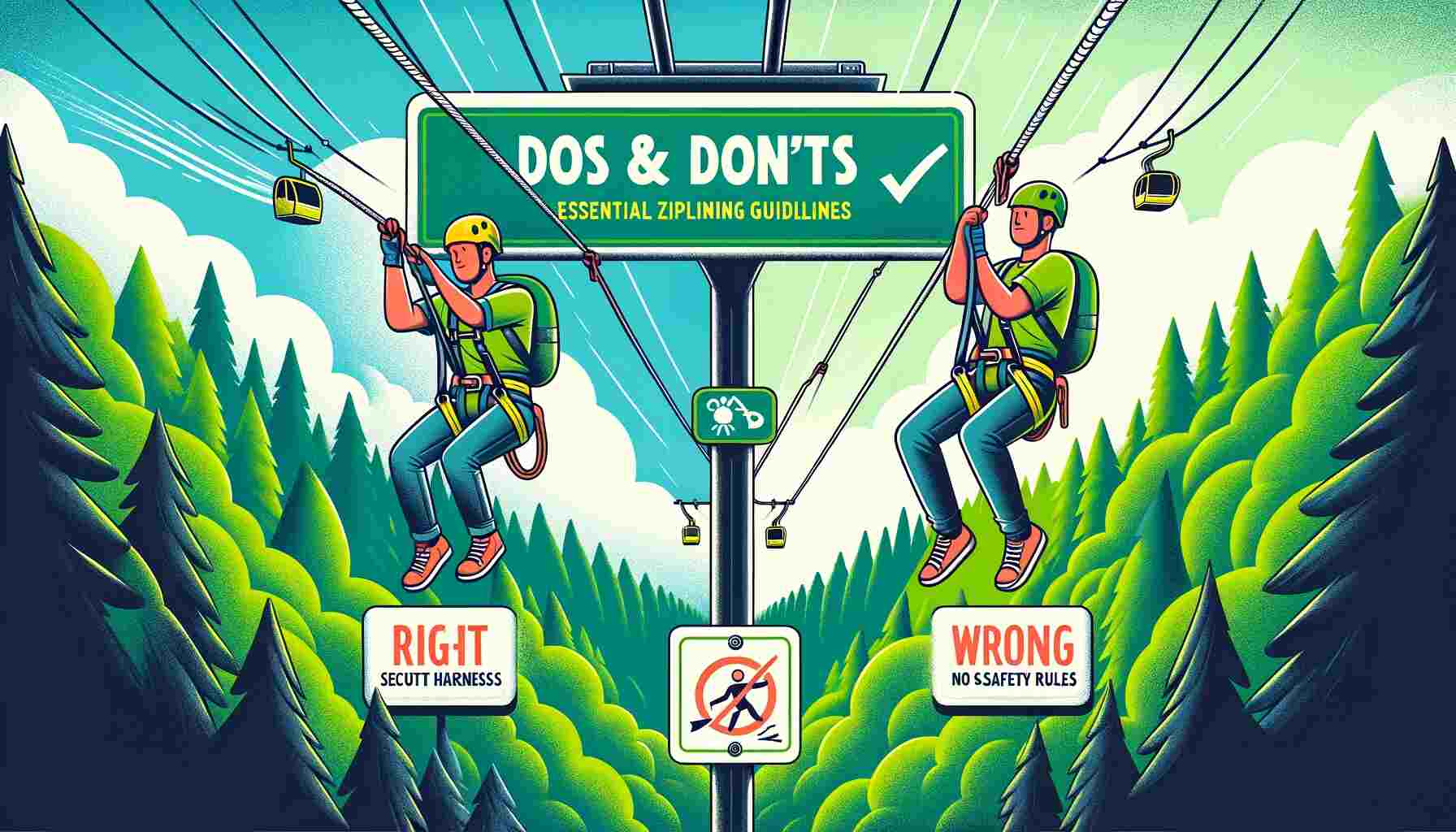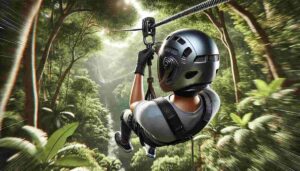Ziplining is a thrilling adventure activity that allows you to soar through the treetops and experience the world from a unique perspective. Whether you’re a first-time zipliner or an experienced enthusiast, adhering to essential dos and don’ts is crucial for a safe and enjoyable experience.
In this comprehensive guide, we’ll explore the world of ziplining and provide you with essential guidelines to ensure your adventure is both thrilling and safe.
Understanding the Basics of Ziplining
Before we delve into the dos and don’ts of ziplining, let’s start with the basics to ensure everyone is on the same page.
What is Ziplining?
Ziplining, also known as zip-lining or canopy tour, is an outdoor adventure activity that involves sliding along a suspended cable from one platform to another. These platforms are usually built high up in the trees or across dramatic landscapes, allowing participants to experience a breathtaking aerial perspective while enjoying an adrenaline rush.
Ziplining has gained popularity worldwide as a recreational activity and is often offered in adventure parks, nature reserves, and even urban environments. The experience typically combines adventure and nature exploration, making it a perfect choice for thrill-seekers and nature enthusiasts alike.
The Equipment
To safely participate in ziplining, you will need specific equipment, including:
- Harness: A full-body harness is worn by participants and is connected to the zipline via a sturdy carabiner or pulley system.
- Helmet: A helmet is essential to protect your head from any potential hazards, such as branches or obstacles along the zipline.
- Gloves: Gloves with a good grip can help you manage your speed and braking while ziplining.
- Trolley or Pulley: This is the equipment that attaches to the zipline cable and allows you to slide along it.
- Braking System: Some ziplines have automatic braking systems, while others require participants to manually brake using a glove or handle.
- Safety Lines and Carabiners: These are additional safety measures that may be in place to prevent accidental falls.
Now that we have a basic understanding of what ziplining is and the equipment involved, let’s dive into the essential dos and don’ts to ensure a safe and exhilarating ziplining experience.
Zipline Dos
1. Do Follow Safety Instructions
Safety should always be your top priority when ziplining. Pay close attention to the safety briefing provided by your guides. This briefing will cover important information about how to use the equipment, what to do in case of an emergency, and any specific rules or guidelines for the zipline you’re about to embark on. Always adhere to the instructions given by the guides or staff members.
2. Do Wear Appropriate Clothing and Footwear
Wearing the right clothing and footwear can make a significant difference in your ziplining experience. Opt for comfortable clothing that allows for ease of movement. Avoid loose clothing that could get caught in the equipment. Closed-toe shoes with good traction are essential, as they provide stability when you land on platforms and help prevent accidents.
3. Do Check Your Equipment
Before you start your zipline adventure, take a moment to inspect your equipment. Ensure that your harness, helmet, trolley, and other gear are in good condition and properly fitted. If anything seems loose or damaged, notify the staff immediately and get it replaced or fixed.
4. Do Pay Attention to Weight Limits
Ziplines often have weight limits to ensure the safety of participants and the integrity of the cables. Make sure you are within the specified weight range for the particular zipline you plan to use. Exceeding the weight limit can put you at risk and may damage the equipment.
5. Do Follow Proper Body Positioning
Maintaining the correct body position while ziplining is crucial for your safety and enjoyment. Keep your body upright and face forward. Avoid swinging or spinning during the ride, as this can destabilize you and make it difficult to control your speed and direction.
6. Do Control Your Speed
Controlling your speed on the zipline is essential for a safe descent. If your zipline has a manual braking system, practice using it during your ride. Avoid sudden stops, and apply gradual pressure on the brake to slow down as you approach the landing platform. If the zipline has an automatic braking system, trust it to slow you down as you reach the end.
7. Do Respect Nature and Wildlife
Ziplining often takes place in natural settings, so it’s important to respect the environment and wildlife. Avoid making loud noises or disturbing animals in their natural habitat. Dispose of any trash properly and follow the “leave no trace” principle by not littering.
8. Do Listen to Your Guides
Zipline guides are trained professionals who are there to ensure your safety and provide you with an enjoyable experience. Listen carefully to their instructions and guidance throughout the adventure. They will often share interesting facts about the area you’re ziplining in, enhancing your overall experience.
9. Do Take in the Scenery
Ziplining offers a unique perspective of the landscape, so don’t forget to take in the breathtaking views and enjoy the natural beauty around you. Capture photos or videos if allowed, but be sure to secure your camera or smartphone properly to prevent any accidental drops.
10. Do Have Fun and Embrace the Adventure
Ziplining is all about having fun and embracing the adventure. Let go of any fears or apprehensions and fully immerse yourself in the experience. The adrenaline rush and the sense of freedom as you glide through the air are what make ziplining so exhilarating.
Zipline Don’ts
1. Don’t Ignore Weight Restrictions
Ignoring weight restrictions can jeopardize your safety and the safety of others on the zipline. Ziplines are designed to accommodate specific weight limits, and exceeding these limits can strain the cables and equipment, increasing the risk of accidents.
2. Don’t Attempt Stunts or Tricks
While ziplining can be an adrenaline-pumping experience, it’s not the time or place to attempt stunts or tricks. Avoid spinning, hanging upside down, or any other risky maneuvers. These actions can lead to loss of control and accidents.
3. Don’t Touch the Zipline
Once you’ve started your zipline descent, refrain from touching the zipline cable or any other equipment with your hands. Doing so can cause friction, burns, or injuries. Use your gloves and braking system, if available, to control your speed and direction.
4. Don’t Overload the Zipline Platform
Zipline platforms are designed to accommodate a specific number of participants at a time. Don’t overcrowd the platform, as it can become unstable and pose a safety hazard. Wait your turn and follow the guidance of the zipline staff.
5. Don’t Bring Loose Items
Leaving loose items in your pockets or hanging from your clothing can be dangerous while ziplining. Items like phones, wallets, or keys can fall and injure you or others below. Secure your belongings in a designated pouch or leave them behind in a secure area.
6. Don’t Rush the Experience
Ziplining is meant to be enjoyed at a controlled and safe pace. Don’t rush through the experience by trying to go faster than recommended or skipping safety measures. Take your time to savor the adventure while prioritizing safety.
7. Don’t Use Unauthorized Ziplines
Ensure that you are using a zipline operated by a reputable company with trained staff and safety measures in place. Using unauthorized or makeshift ziplines can be extremely dangerous and is not worth the risk.
8. Don’t Forget to Stay Hydrated
Ziplining can be physically demanding, especially in hot weather. Don’t forget to stay hydrated by drinking plenty of water before and after your ziplining adventure. Dehydration can affect your concentration and physical performance.
9. Don’t Ignore Health Considerations
Before ziplining, consider your own health and physical condition. If you have any pre-existing medical conditions, such as heart problems or back issues, consult with a medical professional before participating. Ziplining can put stress on your body, so it’s essential to be aware of your own limitations.
10. Don’t Panic in an Emergency
In the unlikely event of an emergency, such as equipment malfunction or a sudden stop mid-zipline, don’t panic. Stay calm and follow the instructions provided by the zipline guides. They are trained to handle such situations and will ensure your safety.
Recommended Gear for Your Ziplining Adventure
To ensure your ziplining experience is safe and enjoyable, having the right equipment is essential. Below are our top picks for the gear you’ll need, all available on Amazon. As an Amazon Associate, I earn from qualifying purchases.
Ziplining Harness
- Petzl CORAX Harness: Known for its versatility and adjustable design, this harness is perfect for ziplining. It provides comfort and safety, ensuring you’re securely attached at all times.
Safety Helmet
- Black Diamond Half Dome Helmet: This helmet offers robust protection with its lightweight design and excellent durability. Ideal for protecting your head from any potential impacts.
Ziplining Gloves
- Outdoor Research ActiveIce Gloves: These gloves are designed to keep your hands cool and provide excellent grip during your zipline adventure. They’re also durable, making them a great choice for regular zipliners.
Footwear
- Merrell Men’s Moab 2 Vent Hiking Shoe: These shoes provide great traction and comfort, crucial for the stable landings on zipline platforms. They’re also suitable for all types of terrains.
Action Camera
- GoPro HERO9 Black: Capture every moment of your thrilling ride with this rugged and waterproof action camera. It’s perfect for recording all your outdoor adventures.
Camera Harness
- STUNTMAN Chest Harness for Action Cameras: Secure your GoPro or any other action camera with this comfortable and adjustable chest harness. It’s perfect for hands-free recording.
Additional Safety Accessories
- Adventure Medical Kits Ultralight/Watertight .7 Medical Kit: Stay prepared for any minor injuries with this compact and waterproof first-aid kit, a must-have for any outdoor activity.
Hydration Solutions
- CamelBak M.U.L.E. Mountain Biking Hydration Pack: Keep hydrated without stopping your adventure with this hydration pack designed for easy access and comfort.
Equipping yourself with the right gear is crucial for a safe and enjoyable ziplining experience. The products recommended above are chosen for their quality and reliability, ensuring you can focus on the thrill of the adventure.
Remember to check each item for the right fit and specifications before your ziplining trip.
Conclusion
Ziplining offers a unique opportunity to experience the thrill of flight while enjoying the beauty of nature. By following these essential dos and don’ts, you can ensure a safe and exhilarating ziplining adventure.
Remember to prioritize safety, respect the environment, and embrace the excitement of the experience. Ziplining is not only about conquering your fears but also about creating lasting memories and connecting with the world in a whole new way. So, gear up, follow these guidelines, and get ready for an unforgettable zipline adventure!










